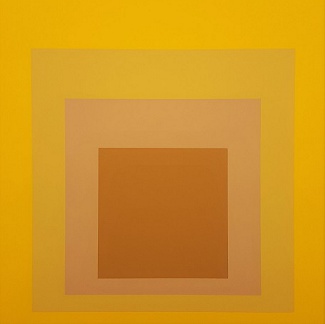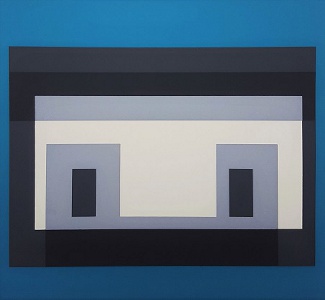

CONTEMPORARY PRINTS
Josef ALBERS (German-American, 1888-1976)
Josef ALBERS (German-American, 1888-1976)
Josef Albers began to paint his "Variant", or
"Adobe", series on his sixth journey to Mexico, in
1947, during a sabbatical from teaching at Black
Mountain College in North Carolina. The vivid
color palette and abstract, geometric compositions
of these works resemble the brightly colored,
painted walls of flat-roofed adobe dwellings that
were common in Mexico at that time. Often
denying that his abstractions made reference to
the material world, Albers insisted that his artwork
titles should be regarded as poetic language rather
than literal references.
Accomplished as a designer, photographer,
typographer, printmaker, and poet, Albers is
best remembered for his work as an abstract
painter and theorist. He favored a very
disciplined approach to composition,
especially in the hundreds of paintings and
prints that make up the series "Homage to the
Square". In this rigorous series, begun in 1949,
Albers explored chromatic interactions with
nested squares. Usually painting on Masonite,
he used a palette knife with oil colors and often
recorded the colors he used on the back of his
works. Each painting consists of either three or
four squares of solid planes of color nested
within one another, in one of four different
arrangements and in square formats.
FINE ART INVESTMENTS SINCE 1978
3430 Red Cloud Trail, Saint Augustine, FL 32086
904-547-2591
gravesfineart1@gmail.com
904-547-2591
gravesfineart1@gmail.com
Josef Albers (German: March 19, 1888 – March 25, 1976) was a German-born American artist and educator who is considered one of
the most influential 20th-century art teachers in the United States. Born in 1888 in Bottrop, Westphalia, Germany, into a Roman
Catholic family with a background in craftsmanship, Albers received practical training in diverse skills like engraving glass,
plumbing, and wiring during his childhood. He later worked as a schoolteacher from 1908 to 1913 and received his first public
commission in 1918 and moved to Munich in 1919.
In 1920, Albers joined the Weimar Bauhaus as a student and became a faculty member in 1922, teaching the principles of handicrafts. With the Bauhaus's move to Dessau in 1925, he was promoted to professor and married Anni Albers, a student at the institution and a textile artist. Albers' work in Dessau included designing furniture and working with glass, collaborating with established artists like Paul Klee. Following the Bauhaus's closure under Nazi pressure in 1933, Albers emigrated to the United States. He was appointed as the head of the painting program at the experimental liberal arts institution Black Mountain College in North Carolina, a position he held until 1949.
At Black Mountain, Albers taught students who would later go on to become prominent artists such as Ruth Asawa and Robert Rauschenberg, and invited contemporary American artists to teach in the summer seminar, including the choreographer Merce Cunningham and Harlem Renaissance painter Jacob Lawrence. In 1950, he left for Yale University to head the design department, contributing significantly to its graphic design program. Albers' teaching methodology, prioritizing practical experience and vision in design, had a profound impact on the development of postwar Western visual art, while his book Interaction of Color, published in 1963, is considered a seminal work on color theory.
In addition to being a teacher, Albers was an active abstract painter and theorist, best known for his series "Homage to the Square", in which he explored chromatic interactions with nested squares, meticulously recording the colors used. He also created murals, such as those for the Corning Glass Building and the Time & Life Building in New York City. In 1970, he and his wife lived in Orange, Connecticut, where they continued to work in their private studio. In 1971, Albers was first living artist to be given a solo show at the Metropolitan Museum of Art in New York. Albers died in his sleep on March 25, 1976, at the Yale New Haven Hospital after being admitted for a possible heart ailment.
In 1920, Albers joined the Weimar Bauhaus as a student and became a faculty member in 1922, teaching the principles of handicrafts. With the Bauhaus's move to Dessau in 1925, he was promoted to professor and married Anni Albers, a student at the institution and a textile artist. Albers' work in Dessau included designing furniture and working with glass, collaborating with established artists like Paul Klee. Following the Bauhaus's closure under Nazi pressure in 1933, Albers emigrated to the United States. He was appointed as the head of the painting program at the experimental liberal arts institution Black Mountain College in North Carolina, a position he held until 1949.
At Black Mountain, Albers taught students who would later go on to become prominent artists such as Ruth Asawa and Robert Rauschenberg, and invited contemporary American artists to teach in the summer seminar, including the choreographer Merce Cunningham and Harlem Renaissance painter Jacob Lawrence. In 1950, he left for Yale University to head the design department, contributing significantly to its graphic design program. Albers' teaching methodology, prioritizing practical experience and vision in design, had a profound impact on the development of postwar Western visual art, while his book Interaction of Color, published in 1963, is considered a seminal work on color theory.
In addition to being a teacher, Albers was an active abstract painter and theorist, best known for his series "Homage to the Square", in which he explored chromatic interactions with nested squares, meticulously recording the colors used. He also created murals, such as those for the Corning Glass Building and the Time & Life Building in New York City. In 1970, he and his wife lived in Orange, Connecticut, where they continued to work in their private studio. In 1971, Albers was first living artist to be given a solo show at the Metropolitan Museum of Art in New York. Albers died in his sleep on March 25, 1976, at the Yale New Haven Hospital after being admitted for a possible heart ailment.


